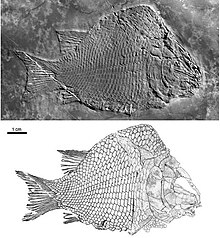Kyphosichthys
| Kyphosichthys Temporal range:Middle Triassic,
| |
|---|---|

| |
| Holotypeskeleton ofK. grandei | |
| Scientific classification | |
| Domain: | Eukaryota |
| Kingdom: | Animalia |
| Phylum: | Chordata |
| Class: | Actinopterygii |
| Clade: | Ginglymodi |
| Order: | †Kyphosichthyiformes |
| Family: | †Kyphosichthyidae |
| Genus: | †Kyphosichthys Xu & Wu,2011 |
| Species: | †K. grandei
|
| Binomial name | |
| †Kyphosichthys grandei Xu & Wu, 2011
| |
Kyphosichthysis anextinctgenusofbasalactinopterygianbony fishknown from the lowerMiddle Triassic(Anisian) marine deposits (Guanling Formation) inLuoping,easternYunnan Province,southwesternChina.[1]The species is the first known fossil record of highly deep-bodiedginglymodians.
Description
[edit]Kyphosichthys(Greekfor "bent fish" ) has a strongly arched hump between the head and the dorsal fin, from which its name derives. Theholotypemeasures 96 mm intotal length,and 76 mm instandard length.The greatest body height occurs at the posterior opercular margin, where the body height is over 70% of the standard length. The dorsal fin and anal fin are located far back on the body, the latter is only half as long as the dorsal fin. The pelvic fins are much smaller than the pectoral fins. The forkedcaudal finis hemi-heterocercaldue to a heavy lobe extending into the dorsal lobe of the fin, but outwardly is nearly symmetrical. The body is covered inganoid scales;those of the anterior flank are decorated with ornate ridges and tubercles while the scales further back are smoother.[1]
In describingKyphosichthys,Xu and Wu compared its body form to modern day deep-bodied fish such as theboarfishand butterflyfish (Chaetodonsp.), and inferred thatKyphosichthyswas similarly a slow swimmer but highly maneuverable, likely adapted to structurally complex habitats.[1]
Classification
[edit]When it was first described,Kyphosichthyswas assigned asincertae sediswithinGinglymodi,a group ofHolosteanfish which includes the livinggarsas well as extinct species. A phylogenetic analysis ofKyphosichthysand otherMesozoicneopterygians placedKyphosichthysin an unresolvedpolytomywithLepisosteus(living gars) and the extinctSemionotus.[1]
References
[edit]- ^abcdXu, G. -H.; F.- X., Wu. (2011)."A deep-bodied ginglymodian fish from the Middle Triassic of eastern Yunnan Province, China, and the phylogeny of lower neopterygians".Chinese Science Bulletin.57:111–118.doi:10.1007/s11434-011-4719-1.
Further reading
[edit]- Benton, Michael J.; Zhang, Qiyue; Hu, Shixue; Chen, Zhong-Qiang; Wen, Wen; Liu, Jun; Huang, Jinyuan; Zhou, Changyong; Xie, Tao; Tong, Jinnan; Choo, Brian (2013). "Exceptional vertebrate biotas from the Triassic of China, and the expansion of marine ecosystems after the Permo-Triassic mass extinction".Earth-Science Reviews.125:199–243.Bibcode:2013ESRv..125..199B.doi:10.1016/j.earscirev.2013.05.014.

